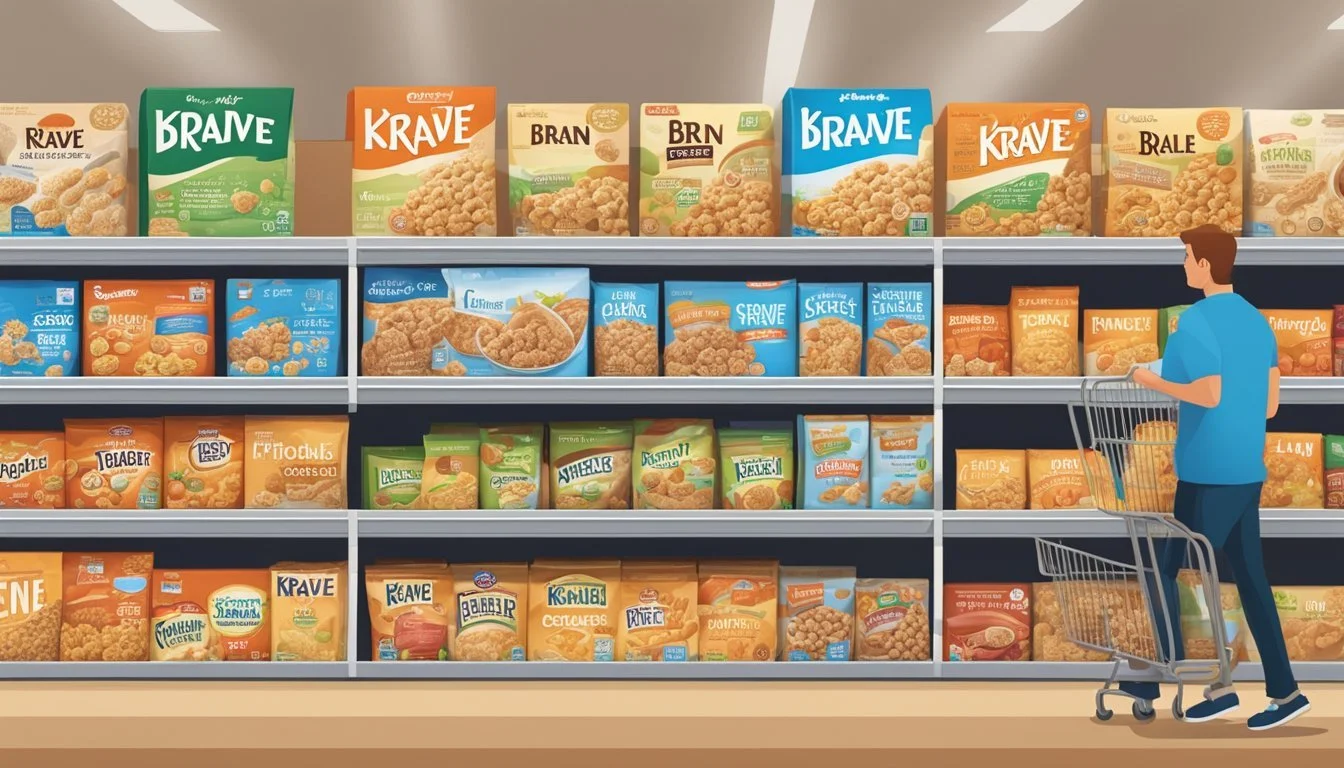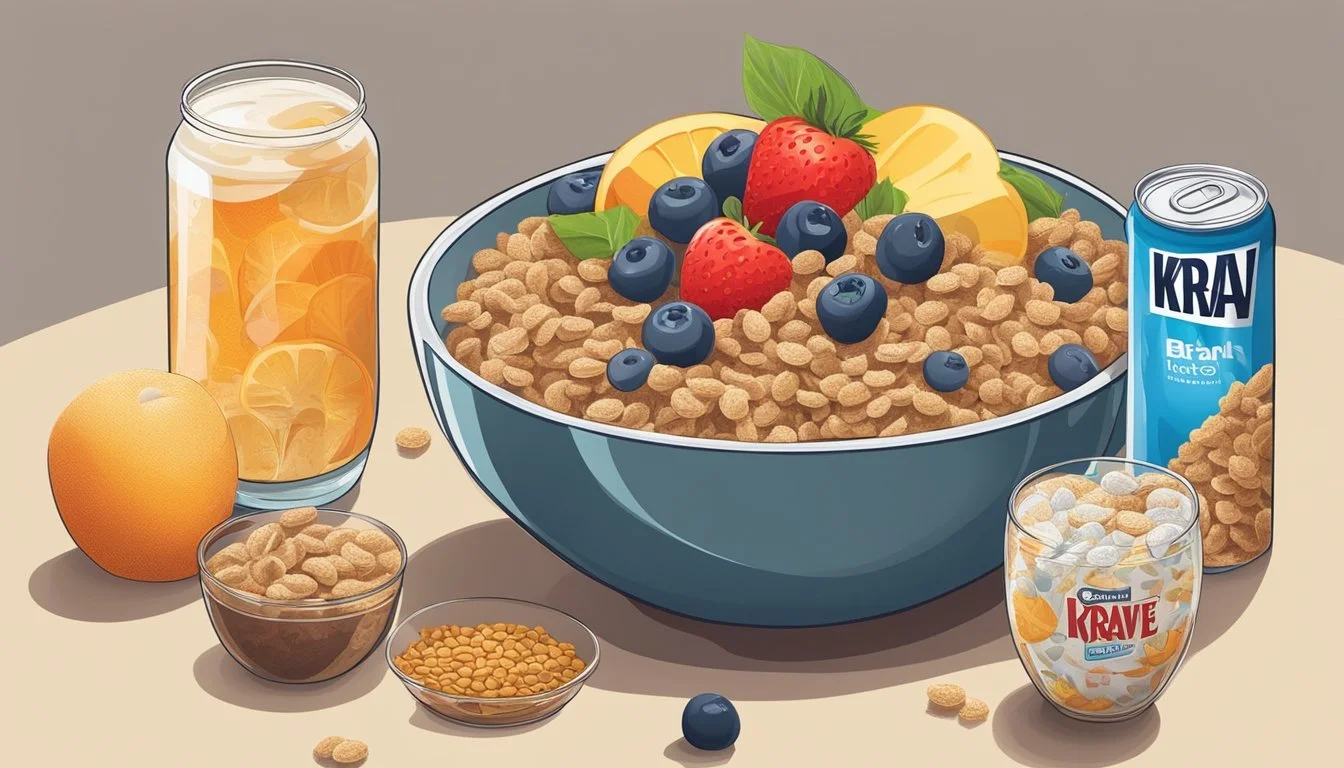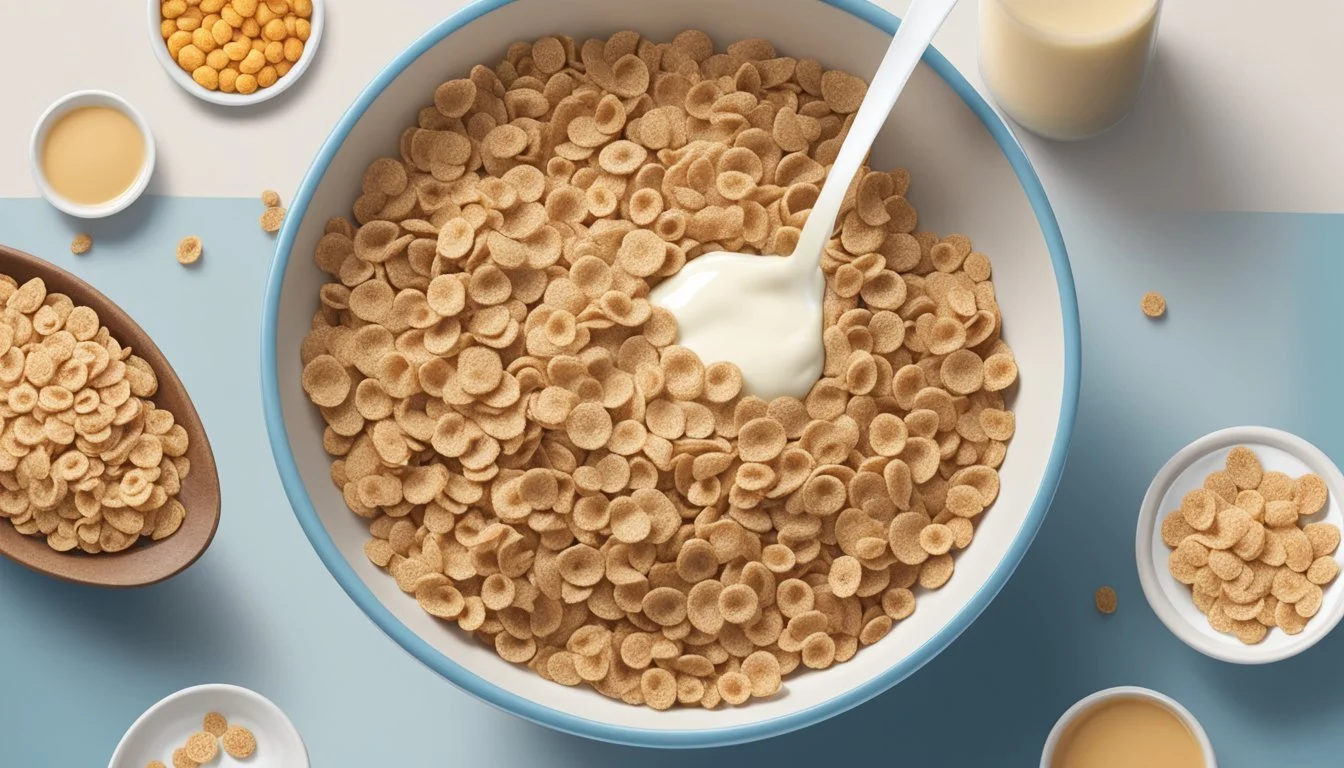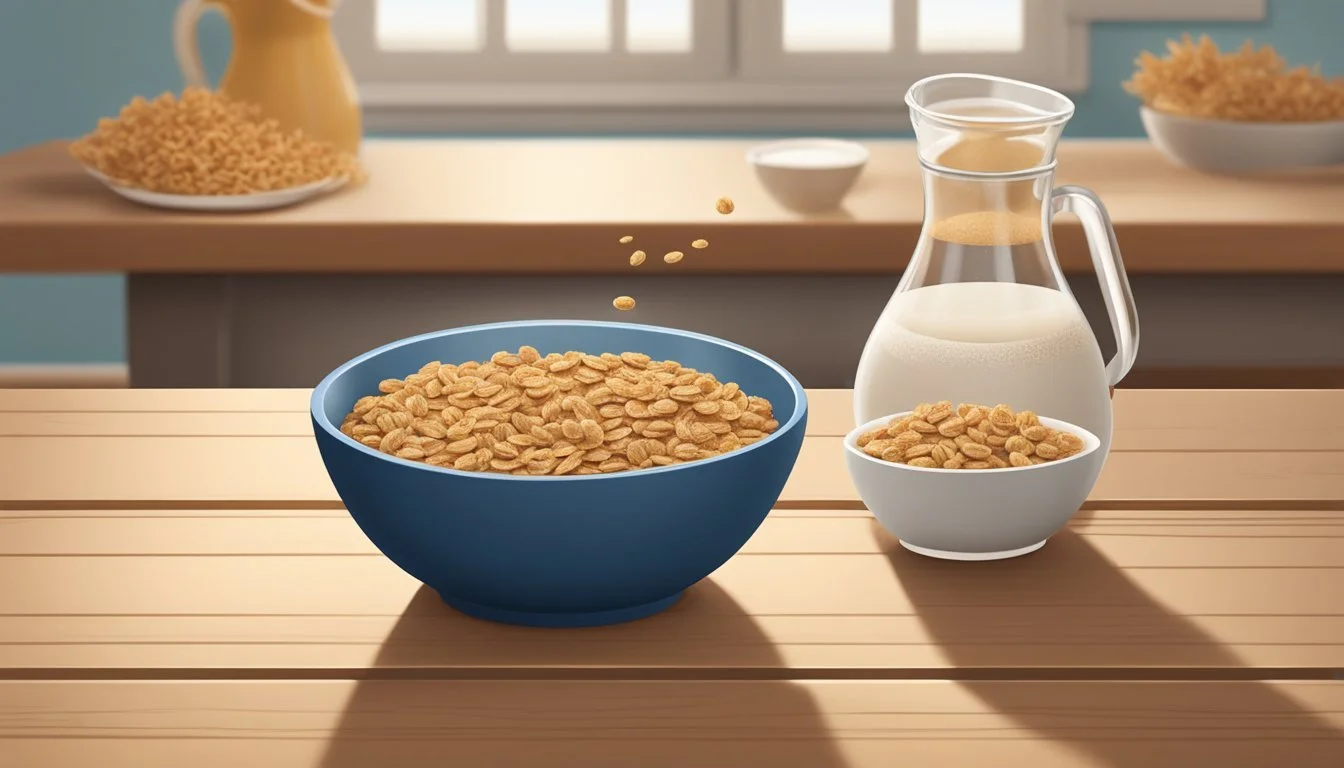All-Bran vs Krave
Nutritional Comparison and Benefits
This Article is Part of Our Breakfast Cereal Guide with Details on All-Bran Nutrition and Krave Nutrition
When it comes to choosing a cereal, the debate between All-Bran and Krave often comes down to health benefits versus taste preferences. All-Bran is known for its high fiber content, boasting 12 grams of dietary fiber per serving, making it a strong choice for those looking to boost their daily fiber intake. This cereal provides a significant portion of the Daily Value (DV) of fiber, which is essential for digestive health.
In contrast, Krave is more of an indulgent option. With its chocolate-filled centers, it caters to those with a sweet tooth. Krave's main appeal lies in its taste, offering a satisfying crunch and chocolatey goodness that make it a favorite among kids and adults alike. However, it isn't as nutrient-dense as All-Bran, with higher sugar and lower fiber content.
Ultimately, the choice between All-Bran and Krave boils down to what one values more in their breakfast cereal: nutritional benefits or flavor. While All-Bran supports digestive health and offers long-term benefits, Krave offers immediate gratification with its sweet and crunchy texture.
Overview of All-Bran
All-Bran is a high-fiber cereal known for its nutritional benefits and positive impact on digestive health. It includes significant amounts of fiber, protein, vitamins, and minerals that contribute to overall health and wellness.
Nutritional Profile
All-Bran Original is notable for its high-fiber content, containing about 10 grams of fiber per serving. This makes it an excellent choice for those looking to increase their daily fiber intake.
Protein is also present, with around 4 grams per serving. Additionally, it provides essential vitamins such as Vitamin B6 and minerals like iron. The cereal includes moderate calories, approximately 110 per serving, ensuring it fits within various diet plans without adding excessive calories.
Health Benefits
The high-fiber content in All-Bran aids in improving digestive health by promoting regular bowel movements and preventing constipation. The presence of fiber is also beneficial for those aiming for weight loss, as it adds bulk to the diet, increasing satiety and reducing overall calorie intake.
Consuming All-Bran can help maintain blood sugar levels, making it a smart choice for individuals managing diabetes or pre-diabetes. The cereal's inclusion of vitamins and minerals, particularly Vitamin B6 and iron, supports overall health, contributing to the proper functioning of the body's metabolic processes and the production of red blood cells.
Overview of Krave
Krave is known for its chocolate flavor and appealing taste, targeting younger audiences and those looking for a flavorful breakfast option. Its notable ingredients and texture also play a key role in its popularity.
Taste and Appeal
Krave stands out with its rich chocolate flavor that is both sweet and indulgent. The texture is crunchy when dry and becomes softer when combined with milk, enhancing its appeal to chocolate lovers.
Additionally, the sweetness of Krave, achieved through added sugars and some natural ingredients like honey, makes it a delightful treat rather than just a typical breakfast cereal.
Though not necessarily marketed as a healthy breakfast option, Krave's taste and texture make it a popular choice for a morning or snack-time indulgence.
Target Audience
Krave targets a younger demographic that includes children and teenagers, as well as adults who enjoy sweet, flavorful cereals. It appeals to those who prefer a chocolate-flavored start to their day rather than a traditional healthy breakfast option.
While it is not specifically aimed at those looking for weight loss or high dietary fiber, Krave occasionally finds a place among individuals seeking a fun, tasty breakfast experience.
The branding and packaging often highlight its chocolate content, making it especially attractive to those with a sweet tooth.
Detailed Comparison
All-Bran and Krave offer distinct nutritional compositions and cater to varying dietary needs. Comparing these cereals highlights differences in macronutrients, vitamins, and suitability for different dietary goals.
Nutritional Analysis
All-Bran serves about 120 calories per serving, while Krave is higher at approximately 150 calories. The protein content is notable in All-Bran, with 4 grams per serving, whereas Krave provides 2 grams.
Sugar Content:
All-Bran has 8 grams of added sugar per serving. Krave, marketed as a more indulgent cereal, contains about 13 grams of sugar. This higher sugar content may appeal to those preferring sweeter cereals but is something to consider for sugar-conscious individuals.
Carbohydrates and Fiber:
All-Bran offers 24 grams of carbohydrates per serving, with a strong emphasis on dietary fiber, providing 12 grams. Krave contains 31 grams of carbohydrates, with relatively low fiber at 2 grams per serving.
Vitamins and Minerals:
All-Bran is fortified with vitamins and minerals, including Iron, Vitamin D, and B Vitamins. Krave also includes these nutrients but places less emphasis on fiber and more on fortification with minerals like Calcium.
Dietary Considerations
Suitability for Diet Plans:
All-Bran, rich in fiber and lower in sugar, aligns well with weight management and digestive health goals. It's suitable for those looking to increase their fiber intake.
Sugar and Sodium Content:
All-Bran’s 260 mg of sodium per serving is manageable for most diets. Krave’s 210 mg of sodium is slightly lower. Both cereals are free from significant cholesterol levels, underlining their heart-health-friendly profiles.
Special Dietary Needs:
For those monitoring sugar intake, All-Bran presents a moderate choice with 8 grams of sugar. Krave, with its 13 grams, might be more suited for occasional indulgence rather than daily consumption.
Conclusion:
While All-Bran is fiber-rich and lower in sugar, making it ideal for health-focused diets, Krave’s higher sugar content and added flavors cater to taste preferences for those wanting an occasional treat. Both cereals provide essential vitamins and minerals, contributing to a balanced diet.
Consumer Considerations
Both All-Bran and Krave cereals have unique qualities that appeal to different consumer preferences. Considering factors like price, texture, and taste can help in deciding which cereal is more suitable for one's needs.
Availability and Price
All-Bran is widely available in most grocery stores and health food outlets. It tends to be moderately priced, often reflecting its high fiber content and healthy benefits. On the other hand, Krave, known for its chocolate-filled indulgence, is also broadly available but may be slightly more expensive due to its dessert-like qualities and marketing as a premium product.
Price considerations can be important for those on a budget. For consumers looking for a healthy cereal option, the cost of All-Bran might seem justified given its high fiber content and minimal fat. In contrast, those who prefer Krave might be willing to pay a bit more for a chocolatey morning treat.
Texture and Taste Preferences
Texture and taste are decisive factors when choosing between All-Bran and Krave. All-Bran has a distinctly crunchy texture which can be appealing to those who enjoy high-fiber cereals. It pairs well with smoothies and yogurt, offering versatility beyond simply a breakfast bowl.
Krave, featuring a crunchy exterior with a creamy chocolate filling, caters to consumers with a sweet tooth. Its cookie-like texture is reminiscent of a dessert, making breakfast feel like a treat.
For those focused on healthy cereal options, All-Bran’s high fiber and low fat content make it a strong candidate. Alternatively, Krave provides an indulgent option without sacrificing crunchiness, appealing to those who prioritize taste and texture over nutritional content.
Health Impacts
All-Bran and Krave cereals differ significantly in their health benefits and concerns. All-Bran offers advantages for digestive health due to its high fiber content, while Krave presents certain health considerations primarily related to its sugar and fat content.
Digestive Health Advantages
All-Bran contains a significant amount of insoluble fiber, which aids in promoting digestive health. This high-fiber content helps in reducing constipation by increasing stool bulk and facilitating regular bowel movements. Products like All-Bran, Bran Flakes, and other high-fiber cereals generally support a healthy digestive system.
In addition to improving digestion, insoluble fiber found in All-Bran may assist in weight management by promoting a feeling of fullness. Other brands like Fiber One also offer high-fiber options, typically without the added sugars, making them beneficial for digestive health.
Krave, on the other hand, has minimal fiber content. This means it does not offer the same digestive health benefits as All-Bran. Moreover, the lack of dietary fiber can lead to missed opportunities for improving gut health and managing digestion-related issues.
Concerns and Considerations
All-Bran does include certain concerns due to its high sugar content. It contains up to 12 grams of sugar per serving, which might contribute to obesity and increased risk of chronic diseases. This added sugar might negatively impact the overall health benefits derived from its high fiber content.
Krave cereal, while often enjoyed for its taste, also contains high levels of sugar and saturated fat, contributing to undesirable health effects such as weight gain and potential heart issues. Unlike All-Bran, Krave’s nutritional profile lacks substantial fiber and potentially beneficial components like Vitamin B12.
Both cereals might contain artificial colors and other additives that could concern health-conscious consumers. When choosing between All-Bran and Krave, it is essential to weigh these health impacts against personal dietary needs and preferences.
Cereal Alternatives
When considering alternatives to All-Bran and Krave, nutritional benefits and the variety they add to your diet are crucial. The options available range from traditional choices like Shredded Wheat to trendy items like granola.
Comparison with Other Cereals
Shredded Wheat, known for its high fiber content, is an excellent alternative to All-Bran. It contains no added sugar and minimal ingredients, which makes it a healthier option. In contrast, Krave's high sugar and lower fiber make it less nutritious. If you're looking for a cereal low in saturated fat, Weetabix is a great option, offering balanced nutrition.
Corn Flakes also serve as a good low-sugar alternative, though they lack the fiber found in All-Bran. Cheerios provide a balanced mix of whole grains and moderate sugar content, making them a versatile choice. Oatmeal stands out as a nutritious and versatile cereal, rich in fiber and beneficial for heart health. For those seeking a crunchy option, Granola often includes nuts and dried fruit, adding antioxidants but watch for sugar content.
Adding Variation to Diet
Swapping cereals regularly can enhance your nutritional intake. For instance, adding Fruit such as Raisins to your breakfast can boost antioxidants and fiber. Including a Whole Grain Cereal daily offers heart health benefits and sustained energy. Trying Gluten-Free options can cater to dietary restrictions without sacrificing nutrition.
Incorporating Oatmeal can provide a warm, comforting start to the day, packed with fiber. Mix it up with fresh fruits or nuts for added flavor and nutrients. Granola can be combined with yogurt for a satisfying meal. The key is to balance taste with health to keep your breakfast both delightful and beneficial.
Conclusion
Both All-Bran and Krave offer unique attributes that cater to different dietary preferences.
All-Bran stands out for its high dietary fiber content. Per serving, it provides 12 grams of fiber, making it an excellent choice for those focusing on digestive health and meeting daily fiber needs. This is especially beneficial for individuals seeking a healthy breakfast to start their day.
Nutritional Information for All-Bran:
Serving size: 2/3 cup
Fiber: 12 grams
Calories: 120
Krave, on the other hand, is known for its taste appeal. It may not provide as much fiber, but it can be a hit among those looking for a more indulgent cereal option. While not the best for dietary fiber, some might prefer its flavor profile.
Nutritional Information for Krave will vary depending on the exact product and serving size, but generally, it tends to be lower in fiber compared to All-Bran.
For individuals focused on a nutrient-dense breakfast, All-Bran's balance of fiber and moderate calories positions it well within a health-conscious diet. Krave may suit those who prioritize taste and are looking for an occasional treat rather than a daily staple.








